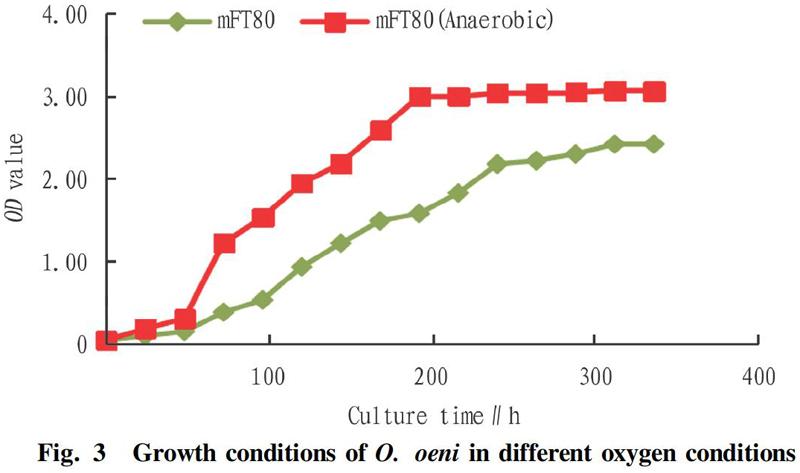Isolation and Screening of Oenococcus oeni and Its Medium Optimization
2021-07-08DongdongHOUXiHE
Dongdong HOU Xi HE



Abstract [Objectives]This study was conducted to further improve the application of Oenococcus oeni in the wine brewing industry. [Methods]O. oeni was isolated, screened, and identified, and medium optimization was performed to determine the best medium, temperature and oxygen conditions. [Results]O. oeni grew better in mFT80 medium, and the culture conditions were 25 ℃ and an anaerobic condition. [Conclusions]This study provides a reference for the development of China's wine industry.
Key words Oenococcus oeni; Isolation and screening; Culture medium; Optimization
The lactic acid bacteria that are initiated in winemaking and participate in malolactic fermentation are called wine lactic acid bacteria. The current research results have found that there are four main genera, namely Lactobacillus, Leuconostoc, Pediococcus and Oenococcus[1]. Among all the malolactic fermentation strains, Otococcus shows excellent wine-making characteristics and has a positive effect on improving the quality of wine. Therefore, the main commercial lactic acid bacteria are Oenococcus oeni[2]. O. oeni is the main species of lactic acid bacteria in grapes and wine. It is an auxotrophic bacterium that can survive under harsh conditions in wine, plays a major role in wine malolactic fermentation (MLF), and is the creator of the final flavor of wine. Lactobacillus plantarum is also a common strain in the fermentation process, which can be used as the promoter of malolactic fermentation[3]. Relevant studies have shown that L. plantarum will produce undesirable secondary metabolites such as biogenic amines during malolactic fermentation, which will cause the wine to produce rat odor and affect the quality and aroma of wine[4]. Therefore, the isolation, screening and identification of O. oeni with excellent wine-making adaptability and wine-making characteristics is of great significance for improving the quality of secondary fermentation of wine.
O. oeni is the main initiator and finisher of MLF in wine, so the culture of O. oeni, especially excellent strains, has always been the focus of the field of wine fermentation[5]. According to the analysis of the medium composition and the understanding of the nutrient requirements of O. oeni, we chose ATB, MRSM and mFT80 media to determine the best medium, and then cultured the bacterium at different temperatures to seek the best culture temperature[6]. After the conditions were determined, the bacterium was comparatively cultured under anaerobic and aerobic conditions to determine the optimal oxygen condition.
Materials and Methods
Materials
Strain
The strain was isolated and screened in wine.
Media
ATB medium: Peptone 10 g/L, yeast powder 5 g/L, glucose 10 g/L, MgSO4·7H2O 0.2 g/L, MnSO4·4H2O 0.05 g/L, cysteine hydrochloride 0.5 g/L, tomato juice 25%.
MRSM medium: Peptone 10 g/L, beef extract 10 g/L, yeast powder 5 g/L, glucose 20 g/L, magnesium sulfate 0.1 g/L, sodium acetate 5 g/L, ammonium citrate 2 g/ L, potassium dihydrogen phosphate 2 g/L, manganese sulfate 0.05 g/L, Tween 80 1 ml/L, L-malicacid 10 g/L, fructose 10 g/L.
mFT80 medium: Beef extract 5 g/L, yeast powder 4 g/L, potassium dihydrogen phosphate 0.6 g/L, potassium chloride 0.45 g/L, calcium chloride 0.13 g/L, magnesium sulfate 0.13 g/L, manganese sulfate 0.003 g/L, Tween 80 1 ml/L, L-malic acid 10 g/L, fructose 35 g/L, glucose 5 g/L.
Main reagents and instruments
Reagents: Cycloheximide; vancomycin; gram dye; 16SrRNA universal primer.
Instruments: Autoclave; clean bench; PCR instrument.
Methods
In this experiment, native O. oeni was first isolated from wine using traditional ATB medium, and its colony morphology was preliminarily verified, followed by sequencing analysis through 16S rRNA. The culture medium and culture conditions were optimized, and the best medium and culture conditions were determined for the selected O. oeni.
Isolation and screening of O. oeni
Liquid ATB culture medium was prepared and added into test tubes, and sterilized for later use. Before using the medium, cycloheximide was added at the concentrations of 10, 20, 30, 40, and 50 mg/L, respectively. The cold-stored wine sample was taken out, and mixed well, and a pipette was used to draw 1 ml of the wine sample into the media, followed by culture in the media at 28 ℃ until the media became turbid. 10, 20, 30, 40, and 50 mg/L vancomycin was added into the ATB solid medium, and the liquid culture media were diluted with sterile water to 10-6 for inoculation. The petri dishes were placed in a 28 ℃ incubator for culture. After the obvious bacteria grew out, Gram staining was performed. The conforming bacteria were streak-inoculated for perseveration and identified by 16S rRNA sequencing.
Optimization of medium and culture conditions
O. oeni was cultured in ATB, MRSM and mFT80 media, and the OD value was observed regularly until it was stable, so as to determine the best medium. The selected best medium was used to culture O. oeni at 20, 25, 28 and 32 ℃, and the OD value was observed regularly until it was stable, so as to determine the optimal growth temperature. O. oeni was then cultured in anaerobic culture bags with the optimal medium at the optimal culture temperature, and the growth was observed under aerobic and anaerobic conditions for comparison. The OD values under the aerobic and anaerobic conditions were monitored until the OD values were stable, and the monitoring ended.
Results and Analysis
Isolation and screening of O. oeni
O. oeni is an auxotrophic strain, and most of the strains lack NAD-glucose-6-phosphate dehydrogenase and need to be able to grow in a medium supplemented with tomato juice growth factor[7]. It can be seen in Table 1 that cycloheximide effectively inhibited yeast and mold at 50 mg/L, and vancomycin at 50 mg/L inhibited other lactic acid bacteria, while O. oeni survived at high concentrations. The selected O. oeni was tested to be positive after Gram staining, and the cell morphology was spherical to elliptical, and often arranged in pairs and chains, and the diameter was less than 1 mm[8]. The results of 16S rRNA sequencing showed that: O. oeni was screened out.
Optimization of medium and culture conditions
Under different media and culture conditions, the growth status of O. oeni was different. From Fig. 1, Fig. 2 and Fig. 3, we can draw the following conclusions: the best culture medium for O. oeni was mFT80, and the best culture temperature was 25℃, and it grew better under anaerobic conditions.
Conclusions and Discussion
After alcoholic fermentation of wine, a relatively complex environment will be formed, with many microorganisms, such as yeast, mold and lactic acid bacteria[9]. In order to screen out O. oeni, it is necessary to inhibit the growth of other microbes. In this study, through a gradient test, it was determined that cycloheximide and vancomycin effectively inhibited the growth of yeast, mold and other lactic acid bacteria at a concentration of 50 mg/L. O. oeni was uninhibited, so it could be screened out from wine.
O. oeni is a kind of auxotrophic bacteria and needs to add corresponding growth factors to grow. In this study, through the study of different media and culture conditions, it was found that O. oeni grew better in mFT80 medium, and the culture conditions were 25 ℃ and an anaerobic condition.
O. oeni is currently recognized as a type of lactic acid bacteria that can quickly adapt to the harsh environment after alcoholic fermentation of wine, such as low pH, high SO2 concentration and high ethanol volume fraction, and can start and execute wine malolactic fermentation[10]. There is a large regional gap between grape planting and wine brewing in China. The isolation, screening and identification of local high-quality O. oeni strains will promote the development of China's wine industry.
References
[1]ZHANG CH. Isolation and screening of Oenococcus oeni in China and research on malolactic fermentation[D]. Yangling: Northwest Agriculture & Forestry University, 2001. (in Chinese)
[2]LI CX. Isolation and Identification of good Oenococcus in China[D]. Yangling: Northwest Agriculture & Forestry University, 2011. (in Chinese)
[3]LI H. Modern wine technology[M]. Xi'an: Shaanxi People's Publishing House, 2001 (in Chinese)
[4]SUN SHU YANG, HAN SHENG WU JIN. Application and validation of autochthonous Lactobacillus plantarum starter cultures for controlled malolactic fermentation and its influence on the aromatic profile of cherry wines[J]. Food Microbiology, 2016(55): 16-24.
[5]LIU F. Study on the winemaking characteristics of Oenococcus oeni[D]. Yangling: Northwest Agriculture & Forestry University, 2002. (in Chinese)
[6]DAN X. Isolation and identification of lactic acid bacteria in different producing areas[D]. Yangling: Northwest Agriculture & Forestry University, 2012. (in Chinese)
[7]SICO MA, BONOMO MG, SALZANO G. Isolation and characterization of Oenococcus oeni from Aglianico wines[J].World Journal of Microbiology and Biotechnology, 2008, 24(9): 1829-1835.
[8]LUCIO O, PARDO I, HERAS JM, et al. Use of starter cultures of Lactobacillus to induce malolactic fermentation in wine. 2017, 23(1): 15-21.
[9]WANG Y. Study on three new structural phenomenon in development of Oenococcus oeni[D]. Yangling: Northwest Agriculture & Forestry University, 2018. (in Chinese)
[10]LIU XJ. Effect of different factors on the malolactic acid fermentation of Oenococcus oeni[D]. Yangling: Northwest Agriculture & Forestry University, 2011. (in Chinese)
杂志排行
农业生物技术(英文版)的其它文章
- Review on Effects of Sunlight on the Internal Quality of Peach Fruit
- Research Progress on Genetic Breeding of Sweet Sorghum Related to Sugar Traits
- Screening of Red-flesh Small Watermelon Varieties for Substrate Cultivation in Spring Greenhouses
- Planting Techniques of Pennisetum giganteum in Huanghuai Area
- Bibliometric Analysis of Status Quo and Trend of the Research on Duck Based on the Web of Science Database
- Preparation and Insecticidal Activity of Sea Anemone Peptide AP-GI from Aiptasia pallida
